After-School Centers and Youth Development
Case Studies of Success and Failure
Barton J Hirsch author Nancy L Deutsch author David L DuBois author
Format:Paperback
Publisher:Cambridge University Press
Published:12th Sep '11
Currently unavailable, and unfortunately no date known when it will be back
This paperback is available in another edition too:
- Hardback£70.00(9780521191197)

This book examines after-school programs, exploring how – and why – young people thrive in good programs and suffer in weak ones.
This book examines after-school programs in light of their explosive growth in recent years. In the rush to mount programs, there is a danger of promoting weak ones of little value and failing to implement strong ones adequately. The authors examine how – and why – young people thrive in good programs and suffer in weak ones.This book examines after-school programs in light of their explosive growth in recent years. In the rush to mount programs, there is a danger of promoting weak ones of little value and failing to implement strong ones adequately. But what is quality and how can it be achieved? This book presents findings from an intensive study of three after-school centers that differed dramatically in quality. Drawing from 233 site visits, the authors examine how – and why – young people thrive in good programs and suffer in weak ones. The book features engaging, in-depth case studies of each of the three centers and of six youths, two from each center. Written in a highly accessible style for academics, youth workers, after-school program leaders and policy makers, the study breaks new ground in highlighting the importance of factors such as collective mentoring, synergies among different programs and activities, and organizational culture and practices.
“This book does a superb job of showing us the difference between what high quality and low quality organizations for youth look like, from the inside out, from the administrative style of the director down to the smallest daily interactions between youth and staff.” – Reed Larson, University of Illinois, Urbana-Champaign
“Hisrsch, Deutsch, and DuBois bring much needed precision to the study of after-school programs. Other studies have shown that program quality varies and demonstrated that quality matters. By focusing on three similar programs, this book tells us how they vary and chronicles the impact these differences have on individual youth. The conceptual framework is powerful in its practical simplicity. The case studies’ dual depiction of the organizations and two of their youths makes this a page turner. The recommendations for improved practice are fresh and specific, and having innovative practices such as collective mentoring and youth councils on the list will propel the field into some overdue discussions. They have definitely turned the lights on in the after-school ‘black box." – Karen Pittman, CEO of The Forum for Youth Investment
"...The authors’ description of the organizational and interpersonal dynamics in the three clubs in their book will have strong appeal and value to researchers and practitioners interested in ideas for improving the quality of after-school centers for today’s adolescents.... Hirsch, Deutsch, and DuBois have provided dramatic evidence for motivating improvements in the organizational cultures of after-school centers so that staff members can say wholeheartedly, “It’s all about the kids.” – Patricia Ashton, University of Florida, PsycCRITIQUES
"...We recommend After-School Centers and Youth Development as valuable reading for anyone concerned with youth development and youth programs. The book is at once soundly grounded in research, while also providing vivid stories that illustrate the enormous range of real-life dynamics in youth organizations. For policy makers and researchers, it is a wake-up call for the importance of a holistic perspective. For undergraduate and graduate students, the book can serve as an effective text that will spark critical conversations tied to theory, management, and child development. For practitioners, the final chapter provides reasonable recommendations on ways of instituting strategies to create a synergistic organization that reverberates high quality and addresses disorder on all levels." –Aisha Griffith and Reed Larson, University of Illinois at Urbana-Champaign, Social Service Review,
- Winner of Social Policy Award for Best Authored Book, Society for Research on Adolescence 2012
ISBN: 9780521138512
Dimensions: 230mm x 155mm x 20mm
Weight: 480g
368 pages